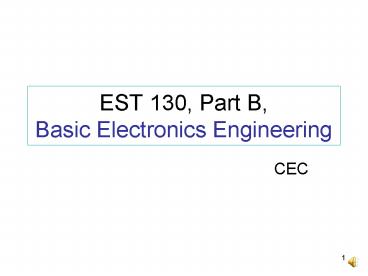Evolution of Electronics Engineering - PowerPoint PPT Presentation
Title:
Evolution of Electronics Engineering
Description:
The attached narrated power point attempts to trace the evolution of Electronics Engineering. – PowerPoint PPT presentation
Number of Views:417
Updated: 1 May 2022
Slides: 18
Provided by:
sunith.cheriyil
Category:
Medicine, Science & Technology
Tags:
Title: Evolution of Electronics Engineering
1
EST 130, Part B, Basic Electronics Engineering
- CEC
2
Coverage
- Definition and Evolution of Electronics.
- Passive and Active Devices.
- Basic Electronic Circuits.
- Public Address System.
- Instrumentation System.
- Analog Communication Systems.
- Cellular Communication Systems.
3
Evolution of Electronics
- CEC
4
Contents
- Meaning of Electronics.
- Milestones/History of Development.
- Impact.
- Applications.
- Classifying Electronic Components.
5
Electronics
- Electronics - Electron Mechanics.
- Branch of science dealing with flow of electrons
and their effects in materials such as vaccum,
gas and semiconductors. - Concerned with design, fabrication and operation
of electronic circuits, devices and systems. - Deals with low ranges of voltage, current and
power (millivolts/milliwatts etc.)
6
Electronics
- Offshoot of electrical engineering.
- Capable of controlling of higher range of
voltage, current and power. - Wide applications in communication,
instrumentation, defence, education, industry,
entertainment etc. - Making life simpler and easier consumer
electronics.
7
Evolution of Electronics
- Edison Effect Thomas Alva Edison (1883),
Electron flow from one metal conductor to another
through vacuum. - Vacuum Diode John Fleming (1904), Edison Effect
through two element electron tube. - Vacuum Triode Lee Dee Forest (1906), triggered
development of electronics.
8
Evolution of Electronics
- Vacuum Tubes used mainly before World War II in
radio communication, telegraphy, telephony etc. - Radio invented by Marconi.
- Television Bell Laboratories demonstrated the
first television (1927). - Transistor John Bardeen, Walter Brattain and
William Shockley, Bell Laboratories, (1947).
9
Evolution of Electronics
- Transistor - light weight, small size, low
power, reliable, low cost etc. - disruptive
technology. - Demonstration of first colour television
(1950), TV invented by John Baird. - Unipolar Field Effect Transistor Schokley
(1952). - Silicon Controlled Rectifier Bell Laboratories
(1956), a new era in power electronics.
10
Evolution of Electronics
- Integrated Circuit Idea by Jack Kilby (1958),
large number of components integrated into a
single chip, beginning of microelectronics
revolution. - Advancements in chip fabrication Small Scale
Integration (SSI), Medium Scale Integration
(MSI), Large Scale Integration (LSI), Very Large
Scale Integration (VLSI) and Ultra Large Scale
Integration (ULSI) low power, more efficient
electronic devices.
11
Generations of Microelectronics
Generation V, 1995, gt 1million transistors/chip.
ULSI
Early 1960s, lt 100 transistors/chip.
SSI
Generation IV, 1975, 10,000 - 1million
transistor/chip.
VLSI
Generation III, 1958.
1969, 1000 10,000 transistors/chip
ICs
LSI
Generation II, 1947.
1966, 100 - 1000 transistors/chip.
MSI
Transistors
Vacuum Tubes
Generation I, Early 1900s.
12
Evolution of Electronics
- Four bit Microprocessor (1971), Intel 4004.
- Eight Bit Microprocessor (1972).
- Gigabit Memory chip (1995).
- Nanoelectronics in action.
13
Applications
- In Industry Automatic Control Systems, Quality
Control of Materials, Automation, Robotics,
Measurements/measuring instruments, in chemical
and explosives industries, automobile, textile
manufacturing and rubber industries etc. - Communication Entertainment Telegraphy,
Telephony, Radio, Television, Music Players,
Mobile Communication, Internetworking, Video
Conferencing and Wireless Communications.
14
Applications
- Medical Electronics ECG, EEG, EMG, MRI, Laser
Applications in Medicine, Computer Tomography,
X-Ray, Ultrasound and Nuclear Imaging, Pace
Maker, Positron Emission Technology,
Telemedicine, Other Medical Diagnostic
Instruments, Assistive Devices. - Military RADAR, SONAR, LIDAR etc.
15
Applications
- Instrumentation Multimeter, CRO, Power
Supplies, Signal Generators, Signal Conditioners
and Other Measuring Instruments, Law Enforcement
and Security Systems, Identification / Identity
Verification Instruments, Air Traffic Control
etc. - Household and Cooking Induction Cooking,
Microwave Oven, Pump Control, Washing Machines
etc.
16
Electronic Components
Electronic Components
Electro-Mechanical
Passive
Active
Eg Diodes, Transistors, FETS, Thyristors, ICs.
Can amplify signals
Eg Resistors, Capacitors, Inductors. Cannot
amplify signals
Eg Relays, Actuators. Used as switches.
17
Thank You

